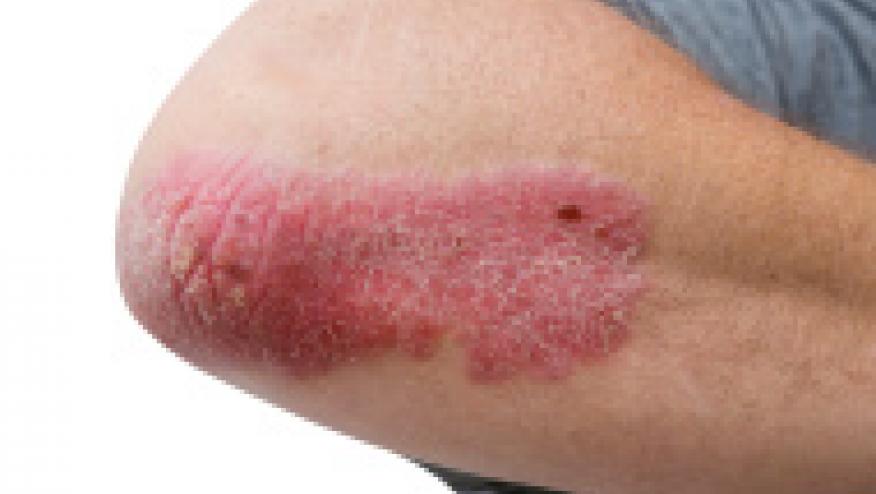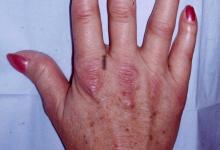Reducing Progression of Psoriasis to Psoriatic Arthritis Save

Key Takeaways
- Psoriasis frequently progresses to PsA, and it has been uncertain whether drugs targeting TNF can delay or prevent it.
- This retrospective analysis examined progression rates in patients with severe psoriasis treated with TNF inhibitors versus phototherapy, over an average of 9 years of follow-up.
- Compared with phototherapy, anti-TNF treatment was associated with half the risk of incident PsA.
Tumor necrosis factor (TNF) inhibitor therapy was effective in reducing the likelihood that psoriasis would progress to psoriatic arthritis (PsA), a retrospective study indicated.
Among propensity-matched patients with severe psoriasis, incidence of PsA over an average of 9 years of follow-up was 1.18 per 100 patients receiving TNF inhibitors, compared with 2.48 per 100 among those treated with ultraviolet-based phototherapy (rate ratio 2.1, 95% CI 1.37-2.98), according to Stefano Piaserico, MD, PhD, of the University of Padua in Italy, and colleagues.
An adjusted model suggested an even greater effect from anti-TNF therapy, the group reported in Rheumatology, yielding a hazard ratio of 0.32 (P<0.0001).
These data indicate that "prolonged [TNF inhibitor] treatment plays a protective role in PsA development in severe psoriasis patients," the researchers wrote. This is important, in that some previous analyses had suggested that TNF inhibitors actually increase risk for PsA in psoriasis patients.
Still, it remains unclear whether TNF inhibitors are the way to go for preventing progression to PsA. One recent study found that another class of biologics -- those targeting interleukin-17 (IL-17) and IL-23 -- outperformed anti-TNF agents in this regard. But that study only had 3-4 years of follow-up, Piaserico and colleagues observed. As with other previous studies, it was "susceptible to biases, such as confounding by indication, protopathic bias, and ascertainment bias," they noted.
In contrast, Piaserico's group looked at outcomes in consecutive psoriasis patients enrolled prospectively during 2005-2010 at five Italian clinics, focusing on those receiving either TNF inhibitors or narrow-band ultraviolet B phototherapy. Specific anti-TNF agents were adalimumab (Humira), infliximab (Remicade), or etanercept (Enbrel). Arthralgia was not an exclusion criterion, unless it qualified for a PsA diagnosis. A total of 946 patients were included, split about evenly between phototherapy and TNF inhibitor groups. For the propensity-matched analysis, 297 in each group were included.
Mean patient age was about 52 and two-thirds were men. Psoriasis duration averaged more than 25 years. At enrollment, mean Psoriasis Area Severity Index (PASI) scores were 16.3 in the TNF inhibitor group and 11.3 among phototherapy users; in the propensity-matched analysis, the corresponding averages were 14.7 and 13.6, respectively (still a significant difference at P=0.039).
In the propensity-matched analysis, 10.7% of the TNF inhibitor group developed PsA, versus 22.2% of the phototherapy group. The difference was narrower at year 5 (5.5% vs 7.1%) but widened as time passed. Among those with 10 years of follow-up, PsA was diagnosed in 10.6% and 18.3% of the anti-TNF and phototherapy groups, respectively.
Importantly, certain baseline factors besides treatment type were also significantly associated with progression to PsA:
- Higher PASI score (HR 1.034 per 1-unit increment)
- Presence of arthralgia (HR 9.45)
- Nail involvement (HR 1.59)
- Family history of PsA (HR 3.7)
Clinicians should be aware of these risk factors, Piaserico and colleagues emphasized.
"A multidisciplinary approach involving dermatologists and rheumatologists in identifying and managing arthralgia could be crucial in modifying disease progression," they wrote. "Future research should investigate the mechanisms linking arthralgia to PsA and assess whether early interventions can prevent long-term joint damage."
The researchers did, however, acknowledge that other biologics may indeed be more effective than TNF inhibitors in preventing psoriasis progression to PsA. They called for further prospective studies to test "whether IL-23/17 axis blockers are even better" than anti-TNF therapy.
Limitations to the study included the fact that it wasn't a randomized trial and treatment choices may have been influenced by unmeasured factors. Results may not apply to anti-TNF agents entering wide use after the 2005-2010 timeframe and thus not examined in the study. As well, patients were enrolled at specialty referral clinics and may not be representative of psoriasis patients in general.
Source Reference:Piaserico S, et al "TNF-alpha inhibitors reduce the incidence of psoriatic arthritis in patients with psoriasis: a propensity score-matched cohort study" Rheumatology 2025; DOI: 10.1093/rheumatology/keaf364.









If you are a health practitioner, you may Login/Register to comment.
Due to the nature of these comment forums, only health practitioners are allowed to comment at this time.